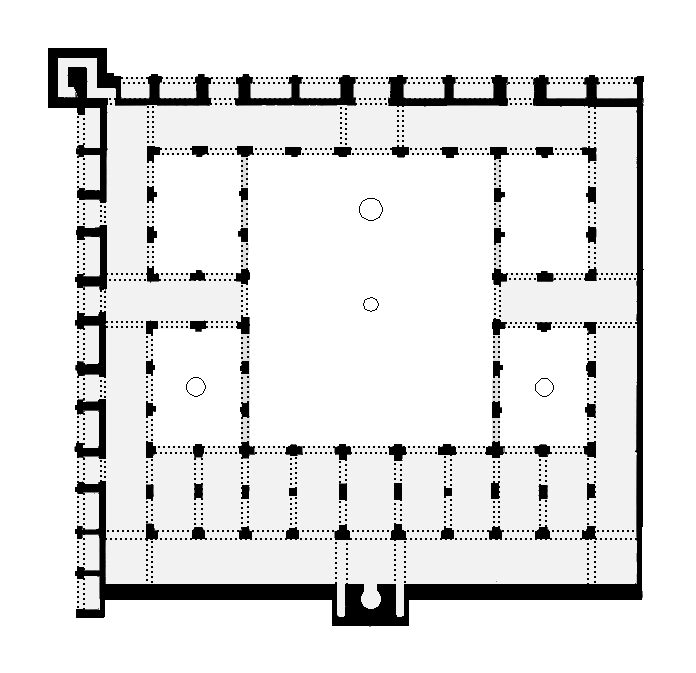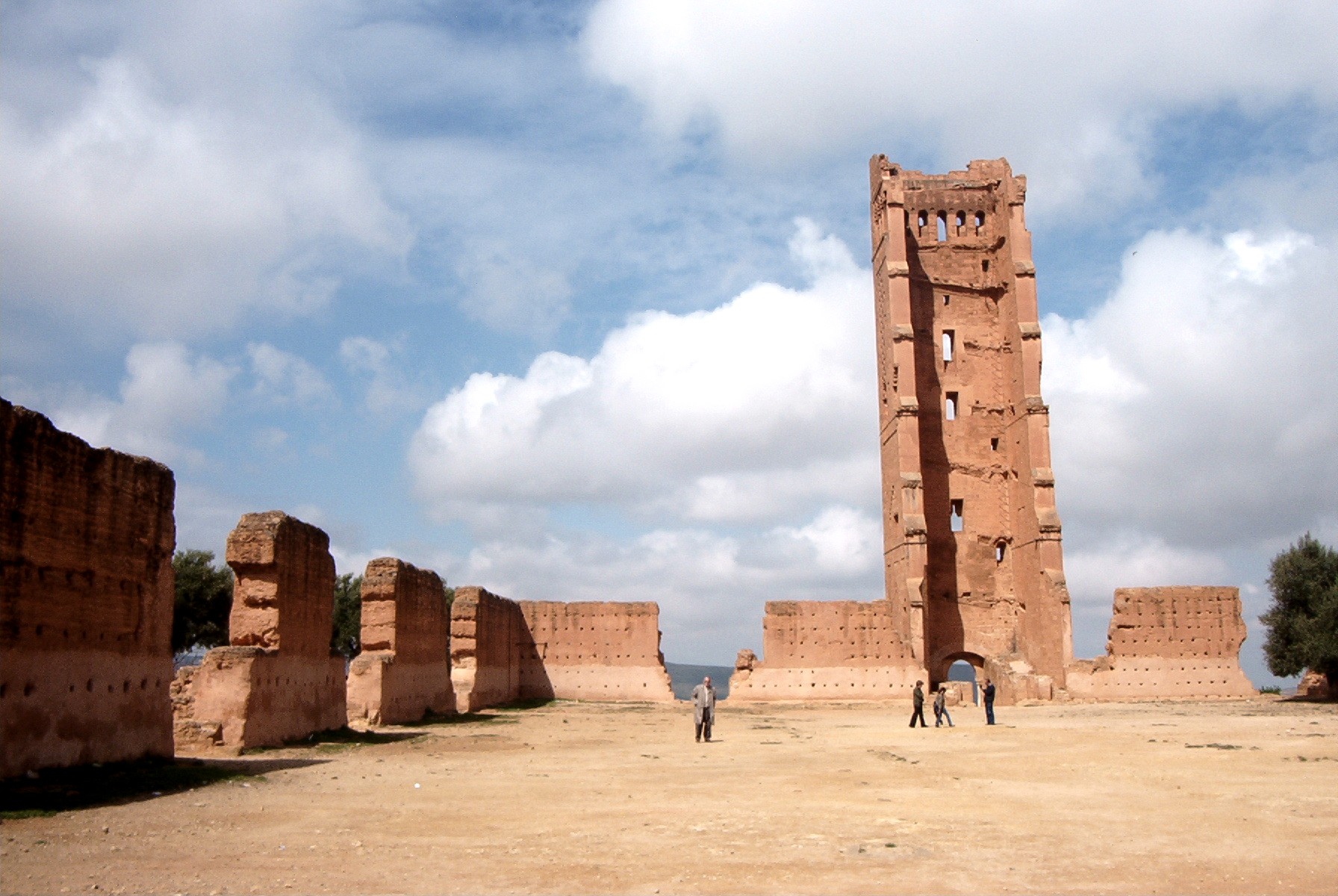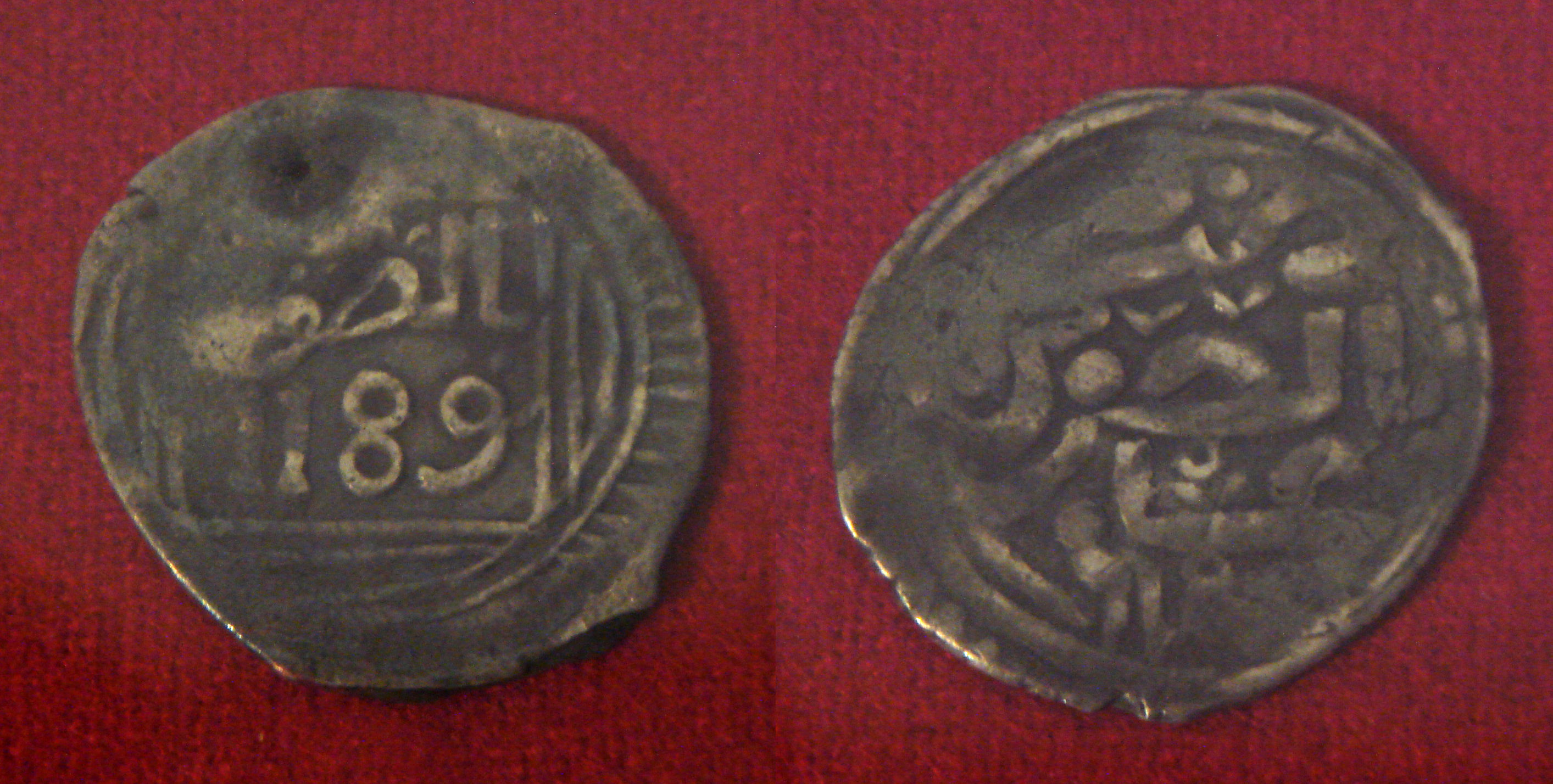|
Kasbah Mosque, Marrakesh
The Kasbah Mosque (), also known as the Moulay al-Yazid Mosque, is a historic mosque in Marrakesh, Morocco. It was originally built by the Almohad ruler Yaqub al-Mansur in 1185–1190 CE. It is located in the Kasbah district, the city's former citadel, near the site of its historic royal palaces. Along with the Kutubiyya Mosque, it is one of the most important historic mosques in Marrakesh. History Construction of the mosque was probably begun around 1185 and finished by 1190 (CE), at the apogee of the Almohad Empire. It was commissioned by the Almohad caliph Yaqub al-Mansur (ruled 1184–1199) as part of the newly created imperial kasbah (citadel) district which was to be the residence of the Almohad Caliph and the seat of government. This followed with a long tradition of rulers in the Islamic world (and beyond) who built palace-cities or separate royal districts. The Kasbah Mosque was built to be the congregational mosque for the caliph and for this royal district, where th ... [...More Info...] [...Related Items...] OR: [Wikipedia] [Google] [Baidu] |
Marrakesh
Marrakesh or Marrakech (; , ) is the fourth-largest city in Morocco. It is one of the four imperial cities of Morocco and is the capital of the Marrakesh–Safi Regions of Morocco, region. The city lies west of the foothills of the Atlas Mountains. The city was founded circa 1070 by Abu Bakr ibn Umar as the capital of the Almoravid dynasty. The Almoravids established the first major structures in the city and shaped its layout for centuries to come. The red Walls of Marrakesh, walls of the city, built by Ali ibn Yusuf in 1122–1123, and various buildings constructed in red sandstone afterwards, have given the city the nickname of the "Red City" or "Ochre City". Marrakesh grew rapidly and established itself as a cultural, religious, and trading center for the Maghreb. After a period of decline, Marrakesh regained its status in the early 16th century as the capital of the Saadian dynasty, with sultans Abdallah al-Ghalib and Ahmad al-Mansur embellishing the city with an array of s ... [...More Info...] [...Related Items...] OR: [Wikipedia] [Google] [Baidu] |
Marinid Dynasty
The Marinid dynasty ( ) was a Berbers, Berber Muslim dynasty that controlled present-day Morocco from the mid-13th to the 15th century and intermittently controlled other parts of North Africa (Algeria and Tunisia) and of the southern Iberian Peninsula (Spain) around Gibraltar. It was named after the Banu Marin (, Berber languages, Berber: ''Ayt Mrin''), a Zenata, Zenata Berber tribe. It ruled the Marinid sultanate, founded by Abd al-Haqq I.C.E. Bosworth, ''The New Islamic Dynasties'', (Columbia University Press, 1996), 41-42. In 1244, after being at their service for several years, the Marinids overthrew the Almohad Caliphate, Almohads which had controlled Morocco. At the height of their power in the mid-14th century, during the reigns of Abu al-Hasan Ali ibn Othman, Abu al-Hasan and his son Abu Inan Faris, Abu Inan, the Marinid dynasty briefly held sway over most of the Maghreb including large parts of modern-day Algeria and Tunisia. The Marinids supported the Emirate of Grana ... [...More Info...] [...Related Items...] OR: [Wikipedia] [Google] [Baidu] |
El Badi Palace
El Badi Palace or Badi' Palace (, also frequently translated as the "Incomparable Palace") is a ruined palace located in Marrakesh, Morocco. It was commissioned by the sultan Ahmad al-Mansur of the Saadian dynasty a few months after his accession in 1578, with construction and embellishment continuing throughout most of his reign. The palace, decorated with materials imported from numerous countries ranging from Italy to Mali, was used for receptions and designed to showcase the Sultan's wealth and power. It was one part of a larger Saadian palace complex occupying the Kasbah district of Marrakesh. The palace was neglected after al-Mansur's death in 1603 and eventually fell into ruin with the decline of the Saadian dynasty. Its valuable materials, particularly marble, were stripped away and reused in other buildings throughout Morocco. Today, it is a significant tourist attraction in Marrakesh and serves as an exhibition space. Notably, the Minbar of the Kutubiyya Mosque is disp ... [...More Info...] [...Related Items...] OR: [Wikipedia] [Google] [Baidu] |
Storks (14003473348)
Storks are large, long-legged, long-necked wading birds with long, stout bills. They belong to the family Ciconiidae, and make up the order Ciconiiformes . Ciconiiformes previously included a number of other families, such as herons and ibises, but those families have been moved to other orders. Storks dwell in many regions and tend to live in drier habitats than the closely related herons, spoonbills and ibises; they also lack the powder down that those groups use to clean off fish slime. Bill-clattering is an important mode of communication at the nest. Many species are migratory. Most storks eat frogs, fish, insects, earthworms, small birds and small mammals. There are 20 living species of storks in six genera. Various terms are used to refer to groups of storks, two frequently used ones being a ''muster'' of storks and a ''phalanx'' of storks. Storks tend to use soaring, gliding flight, which conserves energy. Soaring requires thermal air currents. Ottomar Anschütz's f ... [...More Info...] [...Related Items...] OR: [Wikipedia] [Google] [Baidu] |
Hafidiya
The Hafidiya () was a coup d'état in Morocco between 1907 and 1908 in which Abd al-Hafid seized power from his brother Abdelaziz. Abd al-Hafid started his movement in Marrakesh in the aftermath of the Algeciras Conference, the French occupation of Oujda and of Casablanca and the gaining the support of Amazigh leaders in the south. The ''Ulama'' of Fes supported Abdelhafid only with an unprecedented Conditioned Bay'ah, or pledge of allegiance. Background The Algeciras Conference of 1906 had the effect of dividing Moroccans into supporters of either the Sultan Abdelaziz or his brother Abd al-Hafid into those calling for reform for ''jihad'', respectively. In May 1907, after France had occupied Oujda, the southern aristocrats, led by the head of the Glaoua tribe, Si Elmadani El Glaoui, invited Abd al-Hafid, an elder brother of Abdelaziz and viceroy at Marrakesh, to become sultan, and on August 16, 1907, after the bombardment and occupation of Casablanca, Abdelhafid was p ... [...More Info...] [...Related Items...] OR: [Wikipedia] [Google] [Baidu] |
Abdelaziz Of Morocco
''Moulay'' Abd al-Aziz bin Hassan (), born on 24 February 1881 in Marrakesh and died on 10 June 1943 in Tangier, was a sultan of Morocco from 9 June 1894 to 21 August 1908, as a ruler of the 'Alawi dynasty. He was proclaimed sultan at the age of sixteen after the death of his father Hassan I. Moulay Abdelaziz tried to strengthen the central government by implementing a new tax on agriculture and livestock, a measure which was strongly opposed by sections of the society. This in turn led Abdelaziz to mortgage the customs revenues and to borrow heavily from the French, which was met with widespread revolt and a revolution that deposed him in 1908 in favor of his brother Abd al-Hafid. Reign Early reign Shortly before his death in 1894 Hassan I designed Mawlay Adb al-Aziz his heir, despite his young age, because his mother, Lalla Ruqaya Al Amrani was his favorite wife. (His mother is often confused to be Aisha, the favorite slave concubine of Georgian origins who was bought in Is ... [...More Info...] [...Related Items...] OR: [Wikipedia] [Google] [Baidu] |
Abd Al-Hafid Of Morocco
Abd al-Hafid of Morocco () or Moulay Abdelhafid (24 February 1875 – 4 April 1937) () was the Sultan of Morocco from 1908 to 1912 and a member of the Alaouite Dynasty. His younger brother, Abdelaziz of Morocco, preceded him. While Mulay Abdelhafid initially opposed his brother for giving some concessions to foreign powers, he himself became increasingly backed by the French and finally signed the protectorate treaty giving ''de facto'' control of the country to France. Hafidiya After his brother Abdelaziz appointed him as ''Khalifa'' of Marrakesh, Abdelhafid sought to have him overthrown by fomenting distrust over Abdelaziz's European ties. Abdelhafid was aided by Madani al-Glaoui, older brother of T'hami, one of the Caids of the Atlas. He was assisted in the training of his troops by Andrew Belton, a British officer and veteran of the Second Boer War. In February 1908, Abdelhafid was proclaimed the Sultan of Fes. For a brief period, Abdelaziz reigned from Rabat ... [...More Info...] [...Related Items...] OR: [Wikipedia] [Google] [Baidu] |
Chaouia (Morocco)
The Chaouia () is a plain and historical and ethno-geographical region of Morocco in the historical region of Tamasna, Tamesna. It is bounded by the Oum Er-Rbia River, Oum er-Rbi' River to its southwest, the Cherrate River to its northeast, the plain of Tadla to the southeast and the Atlantic Ocean to the northwest. The region covers a land area of nearly 14 000 km2. The term also refers to a Tribe, tribal confederation that traditionally inhabits the region. Etymology The word "Chaouia" means "Land of Chaouis", transliterated in French language, French. "Chaoui" () is an Arabic word meaning "possessors of sheep" or "shepherds". Some groups of Chaouis claim that the term come from the Arabic term ''shwiya'' (شوية) meaning "few" despite the region now have a comparatively high population density to other regions in Morocco. Others say it is derived from ''shewa'' meaning "grilled meat" or a distortion of ''Chehawna'' which was the name of a tribal alliance. Geograp ... [...More Info...] [...Related Items...] OR: [Wikipedia] [Google] [Baidu] |
Bombardment Of Casablanca (1907)
The Bombardment of Casablanca (; ) was a French naval attack taking place from August 5 to 7 in 1907 that destroyed the Moroccan city of Casablanca. France used mainly artillery fire from armored cruisers to bomb the city and targets in the surrounding area, which caused an estimated 1,500 to 7,000 Moroccan deaths. The bombardment of Casablanca opened a western front to the French conquest of Morocco after Hubert Lyautey's occupation of Oujda in the east earlier that year. The bombardment came after an attack of tribesmen of the Shawiya opposed to the terms of the Treaty of Algeciras of 1906 to the French presence in the customs house and to the construction of a railroad over a sanctuary, specifically on European employees of the Compagnie Marocaine operating a Decauville train from a quarry in Roches Noires to the Port of Casablanca on July 30, 1907. When the French cruiser ''Galilée'' disembarked a landing party of 75 soldiers on August 5, an insurrection broke out in t ... [...More Info...] [...Related Items...] OR: [Wikipedia] [Google] [Baidu] |
Mohammed Ben Abdallah
''Sidi'' Mohammed ben Abdallah ''al-Khatib'' (), known as Mohammed III (), born in 1710 in Fez, Morocco, Fes and died on 9 April 1790 in Meknes, was the List of rulers of Morocco, Sultan of Morocco from 1757 to 1790 as a member of the 'Alawi dynasty. He was the governor of Marrakesh around 1750. He was also briefly sultan in 1748. He rebuilt many cities after the 1755 Lisbon earthquake, earthquake of 1755, including Essaouira, Mogador, Casablanca, and Rabat, and Abdallah Laroui described him as "the architect of modern Morocco." He also defeated the French in the Larache expedition in 1765 and expelled the Portuguese from Mazagan (El Jadida, ''al-Jadīda'') in 1769. He is notable for having been the first leader to recognize American Revolution, American independence in his alliance with Luis de Unzaga 'le Conciliateur' through correspondence and Unzaga's secret intelligence service and led by his brothers-in-law Antonio and Matías de Gálvez from the Canary Islands. He was the so ... [...More Info...] [...Related Items...] OR: [Wikipedia] [Google] [Baidu] |
Alaouite Dynasty
The Alawi dynasty () – also rendered in English as Alaouite, Alawid, or Alawite – is the current Moroccan royal family and reigning dynasty. They are an Arab Sharifian dynasty and claim descent from the Islamic prophet Muhammad through his grandson, Hasan ibn Ali. Their ancestors originally migrated to the Tafilalt region, in present-day Morocco, from Yanbu on the coast of the Hejaz in the 12th or 13th century. The dynasty rose to power in the 17th century, beginning with Mawlay al-Sharif who was declared sultan of the Tafilalt in 1631. His son Al-Rashid, ruling from 1664 to 1672, was able to unite and pacify the country after a long period of regional divisions caused by the weakening of the Saadi Sultanate, establishing the Alawi Sultanate that succeeded it. His brother Isma'il presided over a period of strong central rule between 1672 and 1727, one of the longest reigns of any Moroccan sultan. After Isma'il's death, the country was plunged into disarray as his sons ... [...More Info...] [...Related Items...] OR: [Wikipedia] [Google] [Baidu] |
Abdallah Al-Ghalib
Abdallah al-Ghalib Billah (; b. 1517 – d. 22 January 1574, 1557–1574) was the second Saadian sultan of Morocco. He succeeded his father Mohammed al-Shaykh as Sultan of Morocco. Biography Early life With his first wife Sayyida Rabia, Mohammed al-Shaykh had three sons, but the two oldest had died while he was still alive (in 1550 and in 1551). Abdallah, the third, was 40 years old when he became sultan and received the name al-Ghalib Billah. Before that he had been vice-king of Marrakesh and governor of Fes. Shortly after Abdallah came to power, three of his younger brothers fled the country and joined the Ottoman Turks. Abd al-Malik and Ahmad, both future Sultans of Morocco, spent 17 years in exile in the Ottoman Empire, moving between Algiers and Constantinople, where they were trained by the Ottomans. Battle of Wadi al-Laban He fought the invading Turks in 1558 at the Battle of Wadi al-Laban. The Ottomans then had to retreat because the Spaniards launched an ... [...More Info...] [...Related Items...] OR: [Wikipedia] [Google] [Baidu] |








